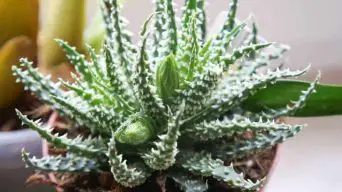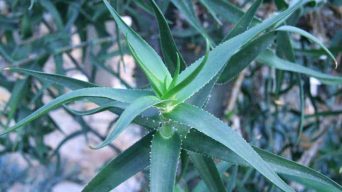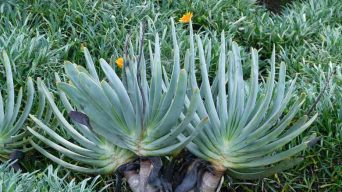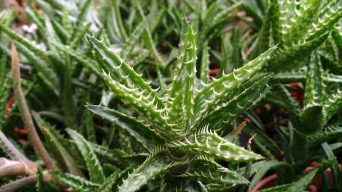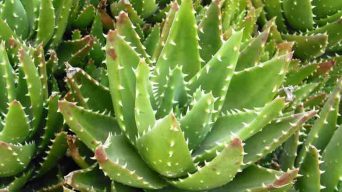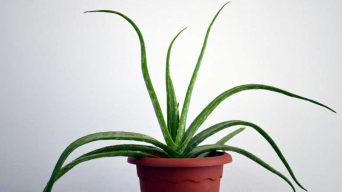The Aloe aristata succulent plant is a beautiful addition to any garden or home.
It has been classified as an endangered species, so propagating these plants from cuttings or seeds will help ensure their survival for years.
This guide will show you how to take care of your Aloe Aristata succulent and how best to propagate it.
Overview
| Family: | Asphodelaceae |
| Genus: | Aristaloe |
| Botanical Name: | Aristaloe aristata |
| Synonyms: | Aloe aristata, Tulista aristata, Aloe longiaristata, Aloe aristata var. leiophylla, Aloe aristata var. parvifolia, and Aloe ellenbergeri |
| Common Names: | Lace Aloe, Guinea-fowl Aloe, or Torch plant |
| Origin: | South Africa and Lesotho |
| USDA Hardiness Zones: | 7 – 11 |
| Size: | 8 inches (20 cm) tall and wide |
| Sun Exposure: | Full sun to partial shade |
| Water Needs: | Water thoroughly but infrequently |
| Soil Type: | Well-draining soil |
| Temperature: | 68°- 80° F (20 – 27°C) during the day and 50° – 70° (10 – 21°C) during the night |
| Humidity Levels: | 40% |
Aristaloe aristata, formerly known as Aloe aristata, is a species of flowering plant in the family Asphodelaceae native to Lesotho and South Africa.
The correct name of this succulent species is Aristaloe aristata, but it’s more commonly referred to as Aloe aristata. It is also often called Lace Aloe, Guinea-fowl Aloe, or Torch plant.
This succulent, fleshy plant often forms dense rosettes of triangular leaves. It usually grows up to 8 inches tall (about 20 cm) and spreads nearly the same in diameter.
The leaves of this succulent are roughly wedge-shaped and dark green, with tiny white bumps along the margins and a sparse covering of white spines at the tips.
This plant produces tall panicles, up to 50 cm (20 inches) tall between late spring and early summer, bearing red tubular flowers.
How To Care for Aristaloe Aristata (Lace Aloe)
Aloe aristata care is easy and can be done by anyone with little time.
While the plant is not very difficult to care for, some general guidelines will help keep your Lace Aloe healthy.
Below you’ll find the essential information you need to know about caring for Aloe aristata.
Sun Exposure & Light Requirements
Aloe aristata require bright light to survive, but they also need enough shade to prevent sunburn.
When grown outside in hot climates, provide partial shade during the hottest parts of the day or grow under a tree with plenty of overhead coverage.
When grown indoors, place your plants near a west-facing or east-facing window with plenty of bright indirect light. Avoid south- and north-facing windows for this plant because it will not get enough sunlight from those directions.
Mature Lace Aloe plants can take full sun just fine. But protect them from intense midday heat by placing them in filtered morning or late afternoon sun exposure.
Watering Requirements
You must water Aloe aristata succulent plants once a week and allow the soil to dry before you water them deeply.
Avoid overwatering these plants, as this can cause root rot, leading to plant die-back or death of your Aloe plant.
Also, ensure that any time you water your Lace Aloe, don’t get water on their leaves because they can quickly rot.
When watering, watering the Aloe aristata succulent plants from below is essential to avoid getting them wet.
Soil Requirements
The soil requirements for the Aloes aristata are a well-draining soil like a cactus or succulent potting mix.
The mixture typically consists of sand, perlite, and peat moss with an equal ratio by volume.
This planting medium is perfect for container and in-ground plants because it helps maintain good drainage while retaining moisture.
A good rule of thumb is to ensure the soil mixture drains well.
The potting container should have a hole at the bottom; you should fill it about three-quarters full with this medium before you plant your Aloe.
It can also help to place pebbles or stones underneath the drainage hole so that if water accumulates, it will drain out onto these materials instead and won’t sit stagnant around the roots.
Temperature and Humidity
Temperature is one of the most important factors when caring for Aloe aristata.
It needs a temperature range between 68°- 80° Fahrenheit (20 – 27°C) during the day and nights between 50° – 70° Fahrenheit (10 – 21°C).
Lower temperatures can lead to brown spots and leaf burn, while higher temperatures can lead to sunburns and desiccation.
The relative humidity is also another critical factor in Lace Aloe care.
It needs around 40% relative humidity when the soil it’s planted in isn’t dry but not overly saturated with water.
The easiest way to achieve this is to ensure the potting mixture has good drainage.
This will allow water absorbed by the soil to be quickly drained off, so your Aloe aristata won’t have any problems getting too wet or dry, and its relative humidity is maintained at a healthy level.
Fertilizing
Aloe aristata succulent plants do not need fertilizing. However, occasional fertilization in the growing season can benefit this plant’s growth.
You can apply a balanced liquid fertilizer diluted to half-strength every two weeks or as needed.
Fertilizer is typically applied at a ratio of about one tablespoon per gallon of water and then watered into the soil around each plant.
Fertilizers should only be applied every other month on container-grown Lace Aloe succulents because over-fertilization could cause them to grow too fast and become leggy.
Potting and Repotting
The Aloe aristata rarely needs repotting, so you should only do it every few years or when its roots get too crowded.
These plants are slow-growing, so it will be a while before they need to be repotted.
When you need to repot the Lace Aloe, use a container about three inches larger than its current pot.
Make sure there are drainage holes in the bottom of this new pot, and fill it with a cactus mix or other succulent soil.
Add water until moist but not soggy before placing your plant into it. You can also place stones in the pot’s base for extra drainage.
Pruning
The Aloe aristata succulent plant does not need to be pruned.
If you feel it needs a clean-up, remove any dead leaves or old stems from the plant.
It does not need much trimming and shaping and looks good just as it grows naturally.
Pests and Diseases
Aloe aristata succulent plants are susceptible to pests and diseases such as Scale, Mealybugs, Root rot, and Alternaria Leaf Spot.
Scale
The most common pest of the Aloe aristata is scale.
Scale are tiny insects that live on plants and suck out the sap, leaving a sticky honeydew residue.
The honeydew attracts more pests like ants or mealybugs to the plant, which can cause even more damage.
To treat scale, use a cotton swab dipped in rubbing alcohol and coat the stem near where you see the pest.
Mealybugs
Another common pest for Aloe aristata plants is mealybugs.
Mealybugs are tiny insects that secrete honeydew as the scale does, attracting ants or other pests to feast on your plant.
To treat mealybug infestations, use a cotton swab dipped in rubbing alcohol and gently rub it on the mealybug.
Mealybugs are often hard to see until they have become an infestation or infection, so prevention with neem oil can be essential for Lace Aloe plants. Neem oil discourages pests from coming into contact with your plant.
Root Rot
Root rot is a common disease that can cause Aloe aristata plants to die. It may be root rot if you see your plant drooping and the leaves are wilting without any other symptoms.
Root rot occurs when the roots of succulents get too wet, sit in water, or do not dry out enough between watering cycles.
Root rot can also happen if you fertilize too much without letting the soil rest before adding more nutrients.
To treat and prevent root rot, allow your potting mix to dry completely before watering again, and keep your plant away from standing water.
Alternaria Leaf Spot
Another common disease for Aloe aristata plants is the Alternaria leaf spot.
This fungal infection mainly affects the leaves of succulents, turning them brown with yellow dots or spots on top that eventually cause the tissue to die and fall off.
To prevent this problem, avoid overhead watering as it spreads quickly when you water from above. This can also encourage pests like mealybugs to climb onto your vulnerable leaves.
To treat the Alternaria leaf spot, remove dead tissue by gently removing infected parts of leaves using a sharp knife. Wear gloves to prevent spreading spores over other areas of foliage.
How to Care for Aloe Aristata in Winter
Winter is harsh for succulents.
When it’s cold outside, they need to be taken inside the house or a greenhouse where their temperature can stay close to 70°F (21C), and they won’t freeze.
You’ll also want them in an area that gets bright light but is filtered through sheer curtains, so direct sunlight doesn’t burn your plants during these short days.
The biggest problem with succulents in winter is their need for bright light.
If it’s cloudy outside, they may not get enough light inside and start to stretch or grow unhealthy new leaves.
So if you can’t provide the plants with sufficient lighting indoors, consider bringing them into a greenhouse where they’ll get plenty of indirect sunlight all day.
Also, you’ll need to water your plants less often in winter. Watering them once a week or even every two weeks may be enough.
Water these plants less frequently during the winter and only water when the top inch of the soil feels completely dry to avoid rot.
How To Propagate Aristaloe Aristata ‘Lace Aloe’
Aloe aristata (Lace aloe) succulents can be propagated by offsets or seeds.
Offsets
Offsets are tiny plants that grow from the edges of an Aloe aristata mother plant. They are easily removed and used to propagate new plants.
To remove an offset, you have to pull it gently. Once removed, allow the offset to dry for a few days before planting in well-draining soil.
They need about the same care as a parent plant, but watering them regularly is essential since they don’t have their roots yet.
The offset can be planted in full or partial sun and should be watered regularly for best results.
Once the new offsets are healthy enough (after about two months), you can start potting up your offsets into individual pots with a well-draining soil mix. Place them outdoors in partial shade during warm weather or indoors when temperatures drop below 50°F/11°C.
Offsets will grow faster than seeds, so keep this in mind before starting propagation by seed.
Seeds
Aloe aristata can also be propagated by seeds, but this is a slower process.
To propagate by seed, leave a few seeds from the parent plant on top of the soil and keep them moist.
As the seeds start to germinate, pot them up and wait until they reach a height of about six inches before you plant.
When planting this way, ensure that each seed has enough space for its roots to spread out laterally to get water and nutrients deep down in the soil.
Is the Aloe Aristata Toxic?
The Aloe aristata plant can be toxic, especially to some pets.
It is advised that humans and animals should not ingest the Lace Aloe plant.
Final Thoughts
The Lace Aloe succulent plant is beautiful, easy to care for, and propagate. It is an excellent plant for beginners and experienced gardeners alike.
Some people are intimidated by growing plants because they think it requires too much upkeep, but this doesn’t have to be true.
With some research, you can learn how to take care of plants like the Aloe aristata and propagate them to fill your home with their beauty!


